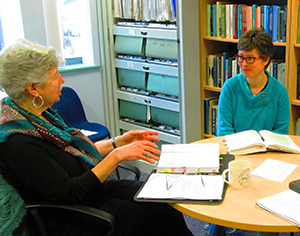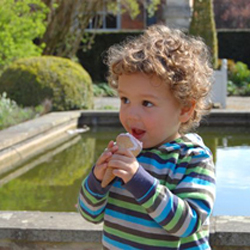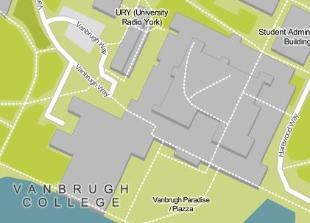York BabyLab Studies

Phonological Development: Perception & Production
Infant and Toddler Studies
York is a leading centre for research and teaching in phonetics and phonology, in first and second language acquisition.
Our team specialises in the study of phonological development. Our research focuses on infants and toddlers, including observational studies of production and experimental studies of word recognition and word learning. We study the relationship between babble and early words, and the shaping of a child's knowledge of the sound system of the language they are learning. We also study how the speech of the adults around them affects infants' learning.
Research
Research in phonological development
How do babies learn to talk?
In the York BabyLab we study many different aspects of this question. We want to know how much parents’ different ways of talking to their children help the children to learn. We are also interested in how babies’ own babbling, and later, their different ways of forming words affect the way they listen to speech and learn more words.
We study children who are slow to begin speaking, to try to explain why some children catch up quickly while others go on to have long-term language problems. And we are interested in how children remember language, and how this is affected by what they already know and the words they are already using.
We use different methods to study these questions: In some cases we visit babies’ homes to record them, in others the family comes to the lab to perform different tasks. We are learning a lot from these activities – and we think the families enjoy them too, not least the babies, for whom everything is new!
Our research is informed by the following Programmes:
1. Interactions between perception & production
It has been well established that infants develop knowledge of the patterns of the native language over the course of the first year of life. At the same time, in parallel, vocal development is marked by a critical milestone at about 6-8 months, with the emergence of canonical babbling (e.g., bababa, dadada – the first adult-like syllable production). One of our major interests is the question of when and how these two strands – advances in infants’ perception and production – come together and influence one another.

2. Phonological templates
Although a baby’s first words are often relatively accurate, in the period that follows we typically find a ‘regression’ in accuracy, with the baby’s words tending to become more similar due to the emergence of one or more production routines or ‘word templates’. We are interested in the ways in which these phonological templates first appear and later fade, in how they differ by ambient language and by individual child within a single language group. Another important question is the extent to which these production templates affect the way children process the speech they hear and the way they remember it – a critical part of new word learning. We are also interested in possible clinical applications of the concept.
3. Effects of input on infant language development
Infants have been shown to be attracted to the variable melodic patterns of ‘infant-directed’ input speech, or ‘baby talk’. Although this speech register is thought to be nearly universal, the style of speech used with babies varies from one culture to another and also between families within a single culture. We are interested in learning more about how these differences affect children’s word learning.
Current Projects
Our projects grow out of our long-term interests and those of our collaborators; our ongoing research and teaching; our students’ interests, and our own observations of the babies that come to our lab. These are the topics that we are investigating in the York BabyLab at the moment:
British and American Infant-Directed Speech Study: Exploring cultural impact on segmentation and word recognition
This study, run in collaboration with Rory DePaolis at James Madison University, aimed to find out at what age British and American infants begin to be able to recognise words embedded within a sentence. We had observed in the past that American babies seemed to be able to do this earlier than British babies and we obtained a year’s worth of research funding from the ESRC to try and work out why.
Loss of ‘universal listening’
Doctoral research by Mariam Dar
Studies have shown that infants in the first months of life can distinguish most of the speech sounds used in different languages, whereas adults have a great deal of trouble learning to hear differences between sounds that don’t occur in their language. The shift away from the ‘universal listening’ of infants seems to occur already toward the end of the first year of life.
ManyBabies 1
Collaboration among c. 60 baby labs worldwide.
Main Investigator: Michael Frank, Stanford University, USA
In this study, multiple labs across the world all run the same experiment: contrasting infants' responses to different styles of adult speech. Comparing results from those different labs will allow us to understand how different cultures and languages affect infant language learning. It will also allow a review of different research methods used by different labs to understand their strengths and weaknesses and improve standards.
This study is funded by the Association for Psychological Science (APS).
BabblePlay app pilot
In collaboration with: Helena Daffern, Rory DePaolis
We are interested in piloting a new app we have developed, the BabblePlay app, with young babies aged 6-8 months. The app responds to sounds the babies make with moving colourful shapes. We hope that once babies see this interesting moving display every time that they vocalise, they will understand that if they vocalise again more shapes will appear. This should, hopefully, encourage them to vocalise more. The ultimate aim of this project is to use this app as a way of encouraging babies to vocalise more, which we believe might help them to start saying words a little earlier. At this stage we are simply trying to find out whether babies can learn to interact with the app, or in other words, whether they seem to understand that the shapes appear because they are vocalising. For this we will measure whether the babies vocalise more when playing with the app than when interacting (or playing) with objects that do not respond to their vocalisations.
Past Projects
Psychological significance of production templates in phonological and lexical advance
This cross-linguistic study ran in 2010, jointly with Rory DePaolis, Ghada Khattab and Sophie Wauquier, and was funded by the ESRC. We worked with colleagues elsewhere in the UK and in France and studied children learning English (in and around York), French (in Paris) and Arabic (in the Lebanon) and looked at the sorts of patterns that toddlers use in each language when listening to and producing words. We followed a small group of children in all three countries over the course of a year, recording and transcribing their speech.
Late talkers
Late talkers are defined as children who have produced few words and no combinations by age two. Many of these children are ‘late bloomers’, who catch up with their peers within a few months. Children who fail to show rapid advance before age 3 may be at risk for either Specific Language Impairment or Dyslexia. We have conducted a study funded by the ESRC to establish the role of phonetic and phonological difficulties in predicting later lexical and grammatical advance.
Infant production and perception
This is a study we ran a few years ago in Wales (see DePaolis, Vihman and Keren-Portnoy, 2011. For a recent replication in Italian see Majorano, Vihman and DePaolis, 2013). It investigates the way in which what an infant can say affects the way they listen to the speech they hear. What we find is that early on infants are mostly drawn to the sounds in the surrounding speech that they can already produce. Later they begin to be more attracted to sounds they are not yet producing, but that are within their reach.
People
Marilyn Vihman

Professor of Linguistics
Marilyn Vihman is a developmental linguist with a primary interest in phonological development. She is best known for her book, Phonological Development: The origins of language in the child, published in 1996. This provides surveys of research on both infant speech perception and early vocal and phonological development. A revised edition, with several new chapters and the new subtitle The first two years, was published in 2014.
Since coming to the UK in 1996 Marilyn has carried out funded research studies that include observational recordings of children learning British English and Welsh, acoustic analyses of English, Finnish, French, Japanese and Welsh babbling and early words, and experiments using the perceptual Head Turn paradigm. Her current research is primarily focused on the formation and later fading of phonological templates in the first years of life. Marilyn is also known for her work on bilingual language development.
Staff profile
Publications
Email: marilyn.vihman@york.ac.uk
Phone: (0)1904 323612
Tamar Keren-Portnoy

Senior Lecturer
Tamar Keren-Portnoy is a developmental psychologist, specialising in the study of first language acquisition. Her main interests are in child phonology and very early syntax. What interests her most is understanding how what a child already knows and is able to do directs their further learning and development. She therefore focuses on investigating mutual effects of production and perception and the way linguistic knowledge develops out of the motoric act of speaking.
Tamar uses naturalistic observation data as well as experimental methods with both infants and toddlers (and a little with adults too).
Staff profile
Publications
Email: tamar.keren-portnoy@york.ac.uk
Phone: (0)1904 323614
Chris Cox

Chris Cox is an MA-student in Phonetics & Phonology and works as a research assistant in the BabyLab. He runs central fixation studies and studies on babble with infants aged 6-12 months.
His main research interests involve studying infants’ categorisation of speech sounds in probabilistic frameworks as well as first and second language acquisition of intonation, rhythm and stress patterns.
He is especially interested in studying the nature of the mechanisms that support the emergence of phonological knowledge in language acquisition.
Email: cmc543@york.ac.uk
Florence Oxley

Florence Oxley is a first year PhD student within the Department of Language & Linguistic Science and has worked as a Research Assistant for the York BabyLab on two projects: Effects of Input and BabblePlay app pilot. She has also been involved in a smaller way in conducting word learning studies with infants using eye-tracking and central fixation.
Her own research interests are infant phonological development, neurolinguistics and the evolution of human communication and language. In particular, she is interested in the evolution of the parts of the brain that support language and communication. Her PhD research examines how babble contributes to brain development and vice versa.
She is also interested in what infants’ perception of emotional state information in pitch can tell us about the evolutionary origins of human communication, language and social culture.
Email: fo507@york.ac.uk
Current Collaborators
| Dunstan Brown | University of York |
| Helena Daffern | University of York |
| Rory DePaolis | James Madison University |
| Ghada Khattab | Newcastle University |
| Marinella Majorano | University of Verona |
| Serge Sagna | University of York |
| Osnat Segal | Tel Aviv University |
BabyLab - get involved!

We have been running the York BabyLab since 2007. This has given us the chance to meet hundreds of families from York and the surrounding areas – and we have learned a lot! However, each research study not only teaches us something about how babies learn to talk but raises many new questions as well. So we always have new studies going on – and we would love to have you and your baby come take part in one!
For some of our studies we invite you to visit the York BabyLab for a short session. In other cases we would like to come visit you at home, to record you and your child playing together. And in a third type of study we give you the ‘LENA device’, for you to record your child and all the speech the child hears over a set period of time (without any of us being present). And then again we sometimes combine two of these study-types in one – depending on what questions we are asking.
- To find out what studies we are currently carrying out in the York BabyLab, visit our 'Current Projects’ tab.
- To take part in one of our studies, please complete our online ‘Sign up for a Study’ form.
- For information about the LENA device, visit ‘LENA device’ page.
- For contact details and information on getting to the York BabyLab, go to the 'Your Visit' tab.
- More information about your visit to the York BabyLab is available on our 'FAQ' tab. This is a collection of questions that parents often ask.
Your Visit
Address:
Infant and Toddler Language Studies Lab
Department of Language and Linguistic Science
V/B/221, 2nd Floor, Block C, Vanbrugh College
University of York
Heslington, York YO10 5DDTelephone: 01904 323619
FAQ for families
How do I take part?
What will happen if we agree to take part and what do we need to do?
Many of our baby language studies involve one visit to our lab at the University for a speech perception experiment. You will be in a large soundproof booth. Your child will be seated on your lap while different types of speech are played through loudspeakers, and your child’s response to this speech will be observed and video-recorded. We flash little lights or show some visual display to make your baby look in certain directions, and the speakers are positioned near the lights or display. You will be asked to use earplugs and wear headphones playing jumbled speech, so that you will not be able to hear the speech your child is hearing. This ensures that your response will not influence your child’s response in any way.
Some of our baby and toddler language studies involve us making some recordings in your home or in the lab. Sometimes this is just a half-hour filming session of you simply playing with your child. Your child will wear a special vest containing a microphone. You will also wear a microphone.
In other studies your baby will be recorded either in your home or in the lab playing on their own with toys and interacting with an iPad app.
Yet other studies involve your baby wearing a digital recording device made especially for babies throughout an entire weekend. The device is known as LENA and enables us to record for a much longer period of time and without an observer present.

